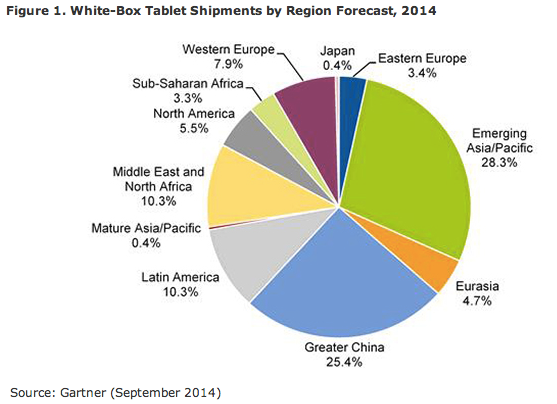They are more than cheap versions and they are showing that they can compete with tier one companies. White label smartphones came to conquer and (behold!) because they'll will surely put a hell of a fight.
Although we are far from being futurologists, of one thing we are certain: the odds appear to be on white label's side. According to a report from Gartner, the sales of white box equipment are higher than ever.
At 2014, they reached 450 million units for smartphones and 74 million units for tablets worldwide . Impressive numbers that can be explained by China's role and the growing of emergent markets such as India or Philippines.
“Selling smartphones is no longer a privilege limited to global original manufacturers”. The words are from a Gartner's researcher, CK Lu, who stresses Chinese capacity to fasten up production with much reduced cost.
But how did white-box devices became so threatening? With the production increase, unknown companies started becoming not so unknown. Clients brought brand awareness and some of them are becoming more and more popular in and outside their home countries.
Harder, better, faster, stronger
“Work it, make it, do it, makes us harder, better, faster, stronger”. Yes, we’re quoting Daft Punk’s 2001’s hit. And we did it because it describes perfectly what is happening to the white label market.
As the time passes, white label companies are less connected with the idea they are worse than the others. In fact, they began to position themselves as sellers of equally good devices with a smaller cost.
One of the major questions is: if the final product is pretty much the same, why is the cost so much lower? The main reason is because white labels traditionally use ready-made chipsets so they can speed up the production.
That acceleration allows OEMS to decrease the final cost in order to make them much more affordable. According with Michael Morgan, senior analyst from ABI Research, “If you look at the market today, it would seem that the OEMs are dictating terms to operator in terms of what the smartphone should do and what it should cost”.
White label smartphones and emergent markets
China, India, Mexico and Brazil are three examples of emerging markets where white labels are proving their value. The lack of purchasing power, together with the high mobile penetration rate, allows us to speak of a democratization process in terms of communication.
In China's particular case, for instance, we can't also ignore the fact that some services, such as Google or LinkedIn, are blocked. The political and technological isolation of the last decades created an eager to learn and that is why there are so many alternatives in the country.
Those alternatives are not only for OEMs, they are for the Internet in general. We just have to look, for instance, at the search engine, Baidu, or the e-commerce platform, Alibaba.
One of the most popular Mobile manufactures in China is Xiaomi, which name can be translated to “little price”.
This article is powered by Aptoide
